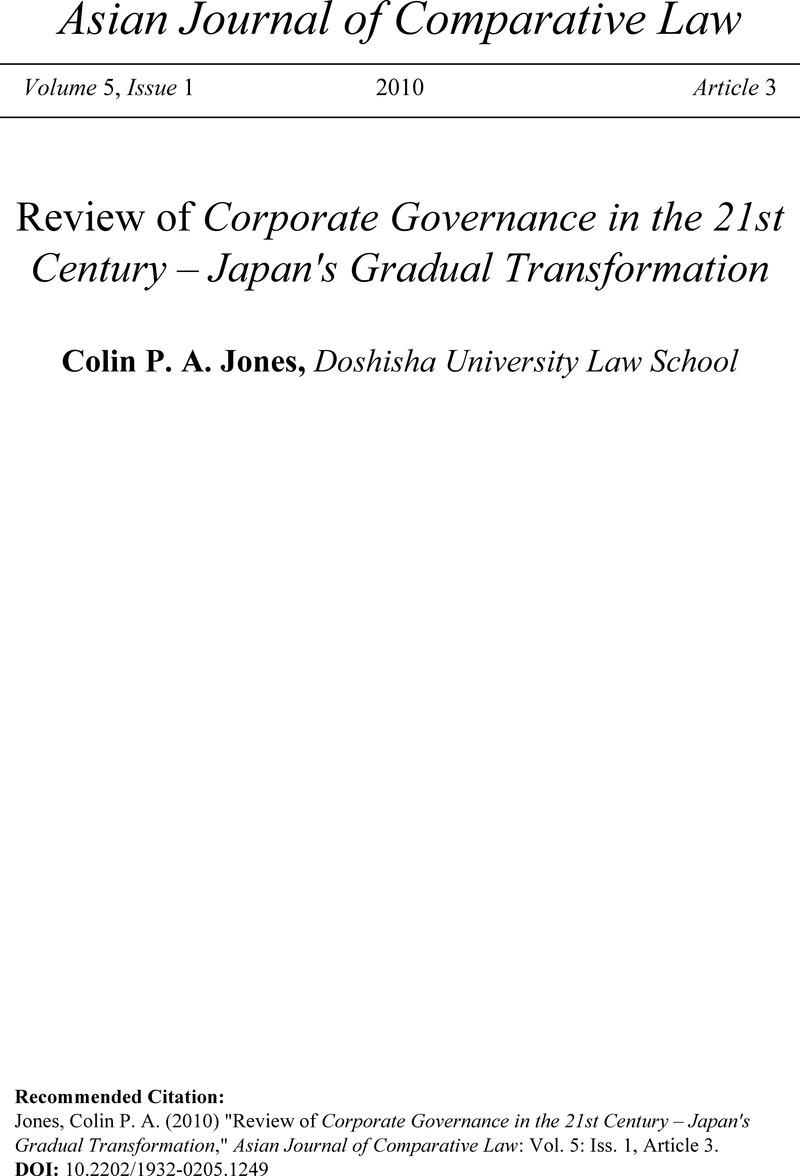No CrossRef data available.
Published online by Cambridge University Press: 16 April 2015

1 The reviewer is also affiliated with ANJeL.
2 Nottage, Luke, “Perspectives and Approaches: A Framework for Comparing Japanese Corporate Governance” in Nottage, , et al. at 28–29 Google Scholar.
3 Ibid. at 52.
4 Wolff, Leon, “The Death of Lifelong Employment in Japan?” in Nottage, , et al. at 53 Google Scholar.
5 Ibid. at 78-79.
6 Miwa, Yoshiro & Ramsyer, J. Mark, “The Myth of the Main Bank: Japan and Comparative Corporate Governance” (2002) 27 Law & Soc. Inquiry 401 CrossRefGoogle Scholar.
7 Puchniak, Dan W., “Perverse Rescue in the Lost Decade: Main Banks in the Post-Bubble Era” in Nottage, , et al. at 81 Google Scholar.
8 Ibid. at 103.
9 Ibid. at 107.
10 Matsui, Tomoyo, “Corporate Governance and Closely-Held Companies in Japan: The Untold Story” in Nottage, , et al. at 108 Google Scholar.
11 Ibid at 119.
12 Lawley, Peter, “Panacea or Placebo? An Empirical Analysis of the Effect of the Japanese Committee System Corporate Governance Law Reform” in Nottage, , et al. at 129 Google Scholar.
13 Ibid at 131.
14 Ibid at 153.
15 Ibid at 154.
16 Dooley, Geread, “Streamlining the Market for Corporate Control: A Takeovers Panel for Japan?” in Nottage, , et al. at 155 Google Scholar.
17 Kamiya, Mitsuhiro & Ito, Tokutaka, “Corporate Governance at the Coalface: Comparing Japan's Complex Case Law on Hostile Takeovers and Defensive Measures” in Nottage, , et al. at 178 Google Scholar.
18 Ibid. at 186.
19 Ibid. at 194.
20 Ibid. at 195.
21 For what it is worth, the reviewer's own thinking on the significance of the Bulldog Sauce line of cases starts with the question: “is it in the interest of the Japanese judiciary or any individual Japanese judge to rule in favor of a foreign investment fund instead of a Japanese company with a history of over a hundred years and which produces a well-known household food product, which the Tokyo High Court made a point of describing as ‘delicious’?”. The answer to this question almost certainly being “no”, the judgments of each layer of the judiciary may reflect nothing more than a series of efforts to come up with the most plausible rationale for a result that was eminently predictable. In this view, the significance of the Bulldog Sauce as “case law” providing a useful guidepost for litigation in future hostile takeovers may be greatly exaggerated.
22 Pokarier, Christopher, “Open to Being Closed? Foreign Control and Adaptive Efficiency in Japanese Corporate Governance” in Nottage, , et al. at 197 Google Scholar.
23 See, e.g. Terada, Shinichi, “Japan Blocks TCI from Upping J-Power Stake” The Japan Times (17 Apr. 2008), online: Japan Times <http://search.japantimes.co.jp/cgi-bin/nb20080417a1.html> (last accessed 14 Jan. 2010)Google Scholar.
24 “Pokarier, supra note 22”, at 223.
25 Ibid. at 227.
26 Kozuka, Souichirou, “Conclusions: Japan's Largest Corporations, Then and Now” in Nottage, , et al. at 228 Google Scholar.
27 Ibid. at 245.
28 Ibid.
29 Basle Committee on Banking Supervision, International Convergence of Capital Measures and Capital Standards (1988), available at: http://www.bis.org/publ/bcbs04a.pdf?noframes=1 (last accessed Feb. 9, 2010).
30 Nakano, M, Amakudari no Kenkyu [The Study of Amakudari] (2009), at 122–123 Google Scholar.
31 Professor Nakano's book provides a wealth of useful data for other national government agencies as well, including the extensive range of companies and positions into which top bureaucrats from each have retired. . Ibid. at 91-224.
32 Although elected governments have repeatedly called for increased restrictions on or the total elimination of amakudari, those restrictions which have been imposed (including an extensive range of prohibitions and limitations contained in Arts. 103-106 of the the National Public Service Act, which among other things prohibit the outright solicitation of post-retirement jobs by regulators from companies they regulate) have simply resulted in the practice morphing into different forms.
33 While the efforts of The Children's Investment Fund to increase its equity stake in J-Power were rebuffed on grounds of national security, it is worth noting that according to the company's annual securities reports, two of J-Power's directors (including its vice president) were former bureaucrats from METI, the electrical power industry's primary regulator, and one of its statutory auditors was a former MOF official.